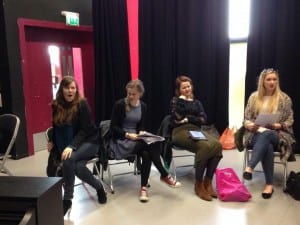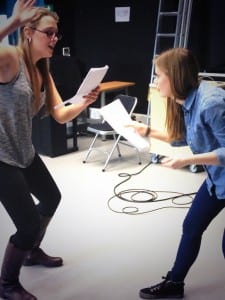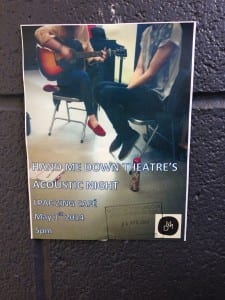While the aim of this module has been to simulate us being part of a real world theatre company, and we have endeavoured make this situation as ‘real life’ as possible for ourselves, we have been aware from the beginning that there are number of areas in which this simulation has not been true to form.
These discrepancies range from our rehearsal space being on campus and therefore being free of charge, our performance space being pre decided and again free, and our actors being students and therefore not needing to be paid. With all of these points ultimately being finance based it can be said that the main falsehood of this simulation has been that our preliminary budget was granted to without us having to apply for it.
While the creativity and the vision of the company can create a play or performance, a company cannot survive without funding. Throughout this process, as mentioned in my previous post, I have been involved in the running of every area of the company. However, company finance, a task that is usually taken on by the producer, has been managed predominantly by Kayleigh, our finance manager, as she has more experience and confidence with budgeting. None the less, in this awareness of our theatre company’s first performance being produced through synthetic means I have come to consider how things would be different if we were to continue the running of our company into the future.
Here, funding would be vital.
Our first and main point of call would certainly be the Arts Council England (ACE). The ACE “are the main body charged with developing the arts in England through the shrewd investment of public funds” (Arts Council England, 2013, 17), funding the likes of artists, theatre companies, museums and touring art projects. The ACE’s mission statement is as follows-
•Talent and artistic excellence and thriving and celebrate
• More people experience and are inspired by the arts
• The arts are sustainable, resilient and innovative
• The arts leadership and workforce are diverse and highly skilled
• Every child and young person has the experience to experience the richness of the arts
(Arts Council England (2011). http://www.artscouncil.org.uk/media/uploads/pdf/Arts_Council_Plan_2011-15.pdf)
In looking specifically at the funding of theatre companies I have found that the ACE have recently initiated a scheme that funds successful applicant companies for three consecutive years, calling these projects National Portfolio Organisations (NPO’s). These NPO’s are all granted funding due to their manifesto adhering to a number of points on the ACE’s personal mission statement, and their application presenting a promising and well thought out plan for the company’s future.
One thing in particular that defines these companies is that NPO theatre companies should seek to “increase access to theatre through touring” (Arts Coucil England, 2012, 1) and where possible, take their work to less arts engaged areas of the country. Our Mission Statement indicates that our work is relatable for a variety of audiences, and we have therefore given ourselves the opportunity to reach a variety of communities with different projects. It would therefore be logical and beneficial to consider where our future performance projects might have the potential to engage with a community on a more personal or educational level. In looking at our debut project and the diverse range of text involved there are a number of subjects within it that could be turned into a workshop-able experience for various audience members. Companies like Filter Theatre, a professional and indeed very successful theatre company who present modern interpretations of Shakespeare often offer, or have available when requested, an actor lead workshop based on the Shakespearean language and how to understand and perform it. Not only can this better engage their audience in the art that they are presenting, but it is undoubtedly a tool that has the potential to generate more interest and money from their respective tour venues.
While I am aware that there are other routes avaible to gain funding, such as applying to charitable organisations such as the Jerwood Foundation, or even applying for crowd funding, for a company of our size a significant amount of money would need to be raised to even pay each member a fair wage. While these alternative funding bodies could help add to our finances the ACE are more likely to contribute a more realistic and workable amount, allowing our company not only to live, but to create and present work that we enjoy.
To find out more about the ACE and their work with theatre companies, visit http://www.artscouncil.org.uk/what-we-do/supporting-artforms/theatre/
Works Cited
Arts Council England. (2011) Diversity. [online] Available from http://www.artscouncil.org.uk/what-we-do/our-priorities-2011-15/diversity/ [Accessed 25 April 2014].
Arts Council England. (2013) Great Art and Culture for Everyone. 10 year strategic framework. 2nd edition. [online]. Available from http://www.artscouncil.org.uk/media/uploads/Great_art_and_culture_for_everyone.pdf [Accessed 30 May 2014].
Arts Council England. (2010) Theatre. [online] Available from http://www.artscouncil.org.uk/what-we-do/supporting-artforms/theatre/ [Accessed 30th May 2014].
Arts Council England. (2011) The Arts Council Plan. [online] Available from Arts Council England (2011). http://www.artscouncil.org.uk/media/uploads/pdf/Arts_Council_Plan_2011-15.pdf [Accessed 25th May 2014].
Filter Theatre (2012) Filter Theatre. [online] London. Available from http://www.filtertheatre.com/page/home/ [Accessed 28 May 2014].




